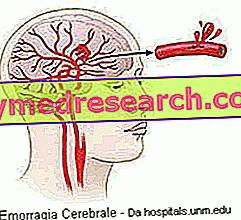What is Cerebral Hemorrhage
Cerebral hemorrhage is a loss of blood within the brain, with a blood loss in the tissues that make it up. It is caused by the rupture of a cerebral blood vessel, typically an artery, following physical trauma or non-traumatic events.

The symptoms depend on the location and extent of the bleeding. A severe headache, followed by vomiting, is one of the most common symptoms of cerebral hemorrhage. The condition is classified as intra-axial intracranial hemorrhage, ie it occurs within the brain tissue rather than outside it. The blood, in fact, can accumulate in the brain tissues or in the space between the brain and the membranes that cover it, causing swelling (cerebral edema) and hematoma. Brain edema and hematoma can cause a sudden increase in pressure inside the skull and cause irreversible damage to the brain tissues involved. Cerebral hemorrhage can be located in only one hemisphere of the telencephalon ( lobar intracerebral hemorrhage ) or extend to other structures of the brain, including thalamus, basal ganglia, cerebellum, brainstem or cortex ( deep intracerebral hemorrhage ). After careful evaluation, doctors can take emergency measures to reduce blood pressure and minimize spillage from the injured blood vessel. The prognosis can improve with an intensive therapy, which aims to stop the bleeding, remove the hematoma and relieve pressure on brain tissues. The patient's age and clinical conditions are elements that contribute to defining the final prognosis.
Causes
Cerebral hemorrhage can be caused by:
- Blood vessel abnormalities (aneurysm or arteriovenous malformations);
- Arterial hypertension: in the long term, high blood pressure can weaken the vessel walls. Chronic arterial hypertension is one of the main causes of cerebral hemorrhage;
- Hemorrhagic transformation of an ischemic stroke;
- Deposition of amyloid substance in blood vessels (amyloid angiopathy);
- Traumatic brain injury: head trauma is the most common cause of cerebral hemorrhage for subjects under the age of 50.
Other causes responsible for cerebral hemorrhage are:
- Hematological diseases and coagulation disorders:
- Platelet disorders (decreased platelet levels);
- Disseminated intravascular coagulation;
- Haemophilia;
- Leukemia;
- Sickle cell anemia;
- Primitive or metastatic brain tumors;
- Liver diseases (associated with an increased risk of general bleeding);
- Therapy with anticoagulant drugs (example: warfarin, heparin etc.).
In some cases, no cause can be found (spontaneous cerebral hemorrhage).
Symptoms
Symptoms may vary depending on the location of the bleeding and appear suddenly or after some time. Furthermore, from the onset these symptoms can progressively worsen or evolve very quickly. Blood effusion can occur near the surface or in deep areas of the brain.
The condition is life-threatening and represents a medical emergency: the accumulation of blood inside the skull can compress the delicate brain tissue, limit the supply of blood and lead to the sudden increase in intracranial pressure, which can lead to to the loss of consciousness, to coma or to death. Some patients may even go into a coma before other obvious signs of bleeding are found.
The most common symptoms of cerebral hemorrhage include:
- Headache (sudden and very intense);
- Nausea and vomit;
- Decreased vigilance, lethargy or confusion;
- Sudden weakness, tingling or numbness of the face, arm or leg, usually on one side;
- Loss of consciousness;
- Temporary loss of sight;
- Convulsions;
- Difficulty speaking, reading, writing or understanding;
- Difficulty in swallowing and alterations in the sense of taste;
- Loss of fine motor skills (example: appearance of hand tremors);
- Loss of coordination and balance.
It is important to consider that many of these symptoms are often caused by conditions other than a brain hemorrhage.
Diagnosis
Based on the clinical presentation, the doctor can determine which part of the brain is involved in cerebral hemorrhage. The condition is often diagnosed as subarachnoid hemorrhage due to the similarity of symptoms and clinical signs. Computed tomography (CT) and other diagnostic investigations help determine the correct therapeutic approach:
- CT can confirm the diagnosis and accurately assess the severity of neurological lesions.
- The magnetic resonance of the brain is necessary, instead, to monitor the reabsorption of the eventual hematoma and detect previous bleeding.
- Angiography allows the detection of cerebral aneurysms, arteriovenous malformations or brain tumors.
- A lumbar puncture (rachicentesi) can be used occasionally to check for the presence of blood in the cerebrospinal fluid.
Treatment
Treatment depends substantially on the type of cerebral hemorrhage (size, position and size) and may include both a pharmacological and a surgical approach. Once the cause responsible for bleeding has been identified, the goals of the therapy are aimed at minimizing the risk of expansion of the bleeding, by controlling blood pressure, correcting any coagulopathy and intervention on vascular lesions with a high risk of acute rebleeding. Body temperature anomalies (hyperpyrexia) are common and can be treated effectively. Respiratory irregularity, pulmonary edema, instability or increased arterial pressure are compensatory reflexive mechanisms determined by the Cushing effect and related to neurological lesions. These cardiovascular and respiratory phenomena aggravate the prognosis, but can be predicted and managed. In general, patients with small blood spills and minimal deficits are treated with medical therapy, while extended hematomas, which compress brain tissue and can cause hydrocephalus (accumulation of fluid in the brain), are surgically managed. Surgery may be necessary to relieve swelling and prevent further blood loss (re-bleeding).
drugs
Drug therapy prescribed for cerebral hemorrhage may include:
- Antihypertensives: in the acute phases, they allow the stabilization of the arterial pressure and guarantee an adequate blood flow to the brain. Blood pressure control helps reduce the risk of re-bleeding;
- Factor VIIa: if administered within 4 hours, it limits bleeding and the formation of a hematoma. However, the risk of thromboembolism also increases;
- Painkillers: include morphine and a combination of codeine and paracetamol, effective to relieve severe head pain associated with bleeding;
- Corticosteroids and diuretics: reduce swelling;
- Anticonvulsants: they are administered to control epileptic seizures (eg: phenytoin);
- Antiemetics: may help relieve symptoms of nausea and general malaise;
- Mannitol: in the acute phases, it is effective in reducing intracranial pressure;
- Acetaminophen: may be necessary to prevent hyperthermia and relieve headaches.
Surgery
Surgery is necessary if the hematoma is greater than 3 cm, if there is a structural vascular lesion or lobar hemorrhage in a young patient. The purpose of surgery is to remove the blood mass and, when possible, to stop the origin of the bleeding. Depending on the position of the clot or hematoma, a craniotomy, an endoscopic drain or a stereotactic aspiration can be performed.
Other treatments
Depending on the patient's symptoms and health conditions, other treatments may be recommended:
- Tracheal intubation is indicated in patients who have a decreased level of consciousness or other risks of airway obstruction;
- Blood products are fluids can be administered intravenously to compensate for the loss of blood and fluids.
Prognosis and Complications
The age of the patient, the extent of the bleeding, the clinical conditions, the site of the cerebral hemorrhage and its dimensions are elements that combine to define the final prognosis. The functional and cognitive recovery is very variable: some patients recover completely after weeks or months after discharge, others have permanent dysfunctions. Despite medical treatment, death is possible and can occur quickly. Possible complications of cerebral hemorrhage include: mood disorders, epilepsy, hemorrhagic stroke and permanent loss of brain function. Even the treatments indicated to control cerebral hemorrhage can determine the onset of serious side effects.



